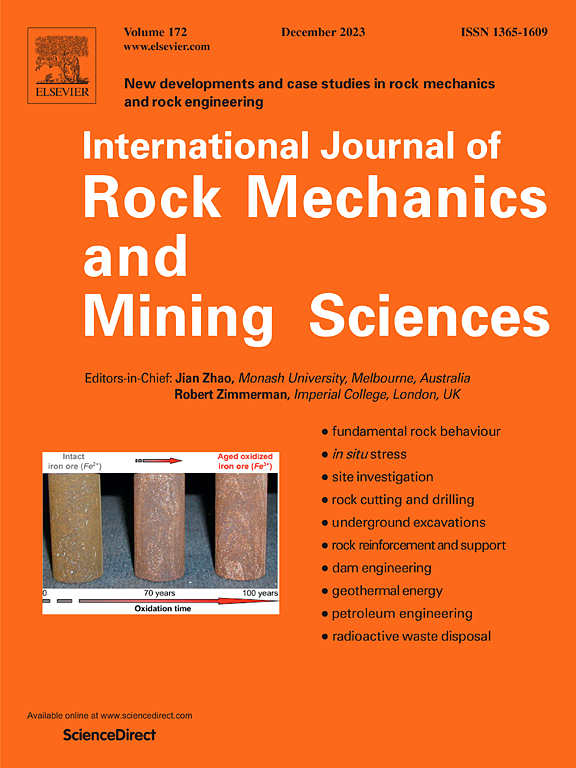Response of a large, low-porosity rock sample to hydromechanical loading
IF 7.5
1区 工程技术
Q1 ENGINEERING, GEOLOGICAL
International Journal of Rock Mechanics and Mining Sciences
Pub Date : 2025-07-30
DOI:10.1016/j.ijrmms.2025.106226
引用次数: 0
Abstract
A laboratory framework is developed for tracking infiltration and measuring hydromechanical parameters of a 150 × 150 × 250 mm3 confined specimen of Westerly granite. Many hydrogeological processes are initiated by fluid infiltration into dry rock, yet assessment of this phenomenon is rare because of the minuscule pore volume Vp (of order 0.1 mL) associated with typical laboratory-sized samples of low-porosity rock. We demonstrate that a single experimental design for measuring infiltration and saturation of a large (Vp of order 50 mL) specimen provides an array of reliable parameters for modeling critical hydrogeological processes and geophysical phenomena. Observing the sample fluid uptake indicates infiltration is modeled effectively by a sharp front separating fluid-infiltrated and dry regions. Additionally, by monitoring the fluid exchange during unjacketed loading, accurate values of the unjacketed pore and bulk Ks′ moduli are obtained, and by using isotropic poroelasticity, the measured and predicted values of Skempton coefficients B are shown to be in good agreement.
大型低孔隙度岩石试样对流体力学加载的响应
开发了一个实验室框架,用于跟踪渗透和测量一个150 × 150 × 250 mm3的西风花岗岩试样的流体力学参数。许多水文地质过程是由流体渗透到干岩石中引发的,但对这种现象的评估很少,因为典型的实验室尺寸的低孔隙度岩石样品的孔隙体积极小(约0.1 mL)。我们证明,用于测量大型(Vp为50 mL)样品的渗透和饱和度的单一实验设计为模拟关键的水文地质过程和地球物理现象提供了一系列可靠的参数。对样品流体吸收量的观察表明,通过将流体浸润区和干燥区分开的尖锐锋面可以有效地模拟入渗。此外,通过监测非夹套加载过程中的流体交换,获得了非夹套孔隙Ks”和体Ks”模量的精确值,并利用各向同性孔隙弹性,得到了Skempton系数B的实测值和预测值。
本文章由计算机程序翻译,如有差异,请以英文原文为准。
求助全文
约1分钟内获得全文
求助全文
来源期刊
CiteScore
14.00
自引率
5.60%
发文量
196
审稿时长
18 weeks
期刊介绍:
The International Journal of Rock Mechanics and Mining Sciences focuses on original research, new developments, site measurements, and case studies within the fields of rock mechanics and rock engineering. Serving as an international platform, it showcases high-quality papers addressing rock mechanics and the application of its principles and techniques in mining and civil engineering projects situated on or within rock masses. These projects encompass a wide range, including slopes, open-pit mines, quarries, shafts, tunnels, caverns, underground mines, metro systems, dams, hydro-electric stations, geothermal energy, petroleum engineering, and radioactive waste disposal. The journal welcomes submissions on various topics, with particular interest in theoretical advancements, analytical and numerical methods, rock testing, site investigation, and case studies.

 求助内容:
求助内容: 应助结果提醒方式:
应助结果提醒方式:


